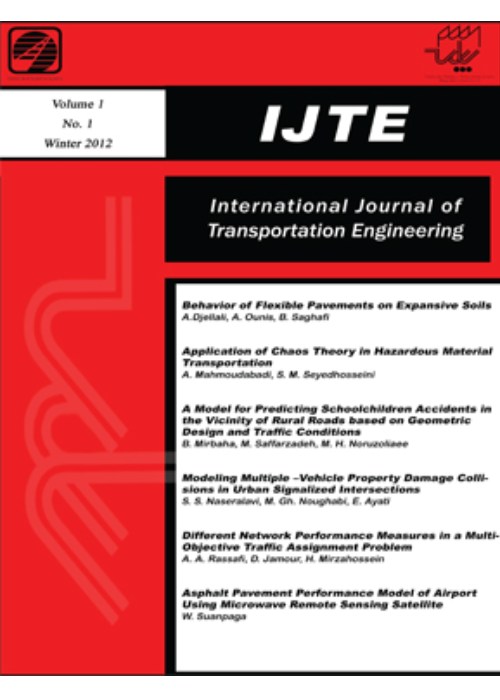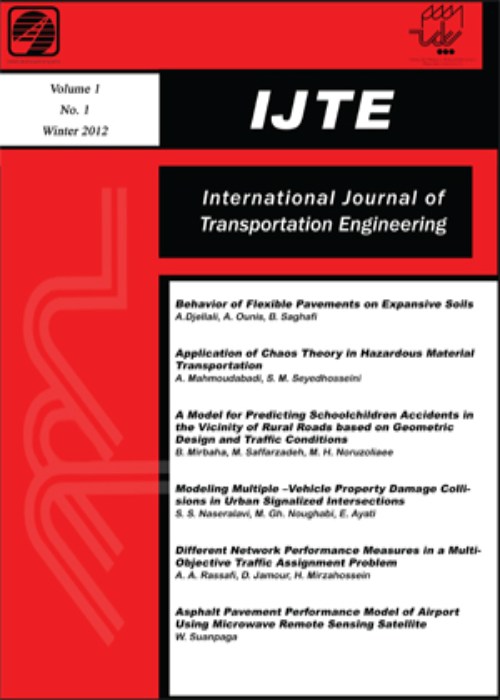فهرست مطالب

International Journal of Transportation Engineering
Volume:10 Issue: 2, Autumn 2022
- تاریخ انتشار: 1401/09/29
- تعداد عناوین: 6
-
-
Pages 959-978The growth and development of urbanization and irregular migration have caused many problems in cities. These issues arose as a result of an imbalanced demand and supply in traffic facilities, resulting in congestion and fuel waste. This problem has explicitly emerged in Iran and is more explicit in Tehran, as its developing capital. One of the main traffic facilities that shows the demand and supply functions is the petrol station. This unbalance is more visible, particularly in Tehran's north, due to high residential density and high land prices. It means it is not possible or cost-effective to construct new stations. Thus, most of the time, long petrol queues waste energy and negatively affect the people in the line. Increasing prices is one of the proper solutions for managing demand to solve this problem, which has been suggested by traffic engineers in recent years. The current study collects data from users of petrol stations in the north of Tehran randomly via questionnaires using the stated preference method to show the sensitivity of price for them. This data is analyzed using SPSS, and the influence of gender, age, residence, education, occupation, car's value, users' threshold of tolerance, and time is investigated. Results show that in all these indices, time has great importance and it makes exceptions. When time is important to the user, he or she is willing to pay more. This is true regardless of the user's wealth, education, job, or place of residence.Keywords: Stated Preference, Increasing Price, Petrol station, Tehran
-
Pages 979-998
The main purpose of this study was to determine the effect of adding polyphosphoric acid (PPA) and rubber powder (CR) on the modification of bitumen properties and also to evaluate the asphalt mixture made of modified bitumen. In addition to the usual tests of new bitumen, a variety of standard tests of strength and modulus of elasticity were performed on the asphalt mixture at high temperatures. The results showed that the addition of PPA improved the performance of bitumen at high temperatures and also reduced the effects of aging in the sample and the addition of rubber powder also improved the performance in the entire operating temperature range of bitumen. The combination of these two additives has also succeeded in reducing the bitumen sensitivity to temperature and aging and also increasing the bitumen resistance to common damages at high temperatures. The combination of these two additives was also able to improve the performance grading of bitumen (PG) to 4 categories without having much effect on the performance of bitumen at different temperatures. In order to investigate the microstructural changes in the samples after modification with rubber powder and polyphosphoric acid, the morphology of the samples was performed by scanning electron microscopy and the uniformity and integrity of the modifiers with bitumen was revealed. Marshall Resistance in modified and average samples increased by 15% compared to unmodified samples and also the modulus of resistance in modified samples increased by 24% on average compared to control samples.
Keywords: modified bitumen, Polyphosphoric acid, Rubber powder, High Temperature Behavior, Asphalt mix -
Pages 999-1013Dynamic Origin Destination (OD) matrix estimation is a classic problem that has long been a subject of scholarly investigation. OD estimation is an essential prerequisite for transportation planning and traffic management. Despite the plethora of research on this subject, most models available in the literature fail to present the elegant characteristics of OD time series data. The patterns in OD time series break down into regular and particular patterns. However, most studies in literature focused on the regular type. Broadly the regular patterns are used to represent the general distribution patterns in time-dependent OD demands. Although, uncontrollable variables such as weather conditions, events, time, and crashes affect the OD patterns considerably. So, considering the impact of these uncontrolled variables, we developed a time series prediction algorithm model that can show both regular and particular patterns. The proposed model classifies historical data and estimates the class of coming demand. The clustering and association rule techniques are used in the proposed model to predict the coming OD. The bike riding data in Chicago was used to test the algorithm and the results suggest that the model can predict the class of OD with above 80% accuracy with a reasonable number of classes.Keywords: time series, Origin Destination Matrix, Classification, Pattern Recognition, Traffic management
-
Pages 1015-1025Modeling the crash severity based on the influential variables makes it feasible to predict the occurrence of crashes that requires safety solutions. In addition, the influence of each factor in the crashes can be examined. This study aimed to identify the factors affecting the severity of the injury/fatal and property damage only (PDO) crashes of taxi vehicles in Rasht city, Iran, by collecting crash data from March 2015 to March 2021. In this regard, the Friedman test was used to determine the priority of factors, and the factor analysis was applied to specify the most effective factors on the severity of taxi-related crashes in Rasht city. According to the Friedman test, weather conditions were the most significant factor affecting the crashes. Based on the factor analysis, five factors were specified as the principal factors contributing to crashes that the environmental factor was the first factor involved in crashes, which includes weather conditions, road surface conditions, and daylight conditions. So weather conditions as the environmental factor was determined the main influential factor on the taxi-related crashes of urban roads.Keywords: safety, Taxi crashes, Friedman Test, Factor analysis
-
Pages 1027-1039
Monitoring and evaluating driving behavior indirectly reduces accidents and fuel consumption. But this evaluation is not available due to the need for expensive equipment. In this study, an expert system is presented which allows fuzzy evaluation of drivers` behaviors by using smartphone sensors. The proposed model, first identifies different types of maneuvers such as changing lane, road ramps, turning left or right based on cell phone sensors fusion. Then, the expert system uses fuzzy C-mean clustering technique to determine the overall behavior of the drivers into two categories, aggressive and safe, based on the type of maneuver and the lateral acceleration during the maneuver. Results show fusion of smartphone inertial measurement sensor (IMU) sensors based on the adaptive neuro fuzzy inference system (ANFIS) detect correctly the type of maneuvers near 96%. Also, in order to validate the results of assessing driver behavior, the well-known Driver Anger Scale questionnaire is used. The output obtained from the proposed model confirms the results of the questionnaire.
Keywords: driver behavior, Vehicle Maneuvers Detection, Sensor fusion, Smartphone sensor, Intelligent Transportation System -
Pages 1041-1054Accurate assessment of motorcycle safety requires examining the complex relationships between vehicles, roads, and human factors involved in a crash. This study deals with the case study of Mashhad as one of the metropolises of the country. It investigates the role of different characteristics in the severity of motorcycle crashes by examining 9663 cases of motorcycle crashes in the three-year period from 2014 to 2016. For this purpose, the study uses the descriptive analysis of the data and a logistic regression model. The variables studied in this paper are divided into three categories: crash variables, environmental variables, and motorcyclist variables. Investigation of crash variables shows that the probability of fatal crashes increases from 22 to 10 in the morning. Further, the probability of a motorcyclist's death in crashes with heavy vehicles and crashes without another involved party is 3.27 and 4.41 times higher than that of a motorcyclist in a crash with light vehicles. Environmental variables indicate that the probability of more severe motorcycle crashes increases in roundabouts, roads with recreational use, and expressways. Further, the severity of crashes increases on highways and roads with shoulders, divided medians, higher speed limits, and roads without adequate lighting. In addition, the variables related to motorcyclists show that the probability of more severe crashes rises with the increasing age of motorcyclists. Finally, this study analysis the role of various factors, examines the problems in crash information, and offers solutions related to improving the safety of motorcyclists.Keywords: Crash, Motorcycle, Vulnerable User, logistic regression, crash severity


